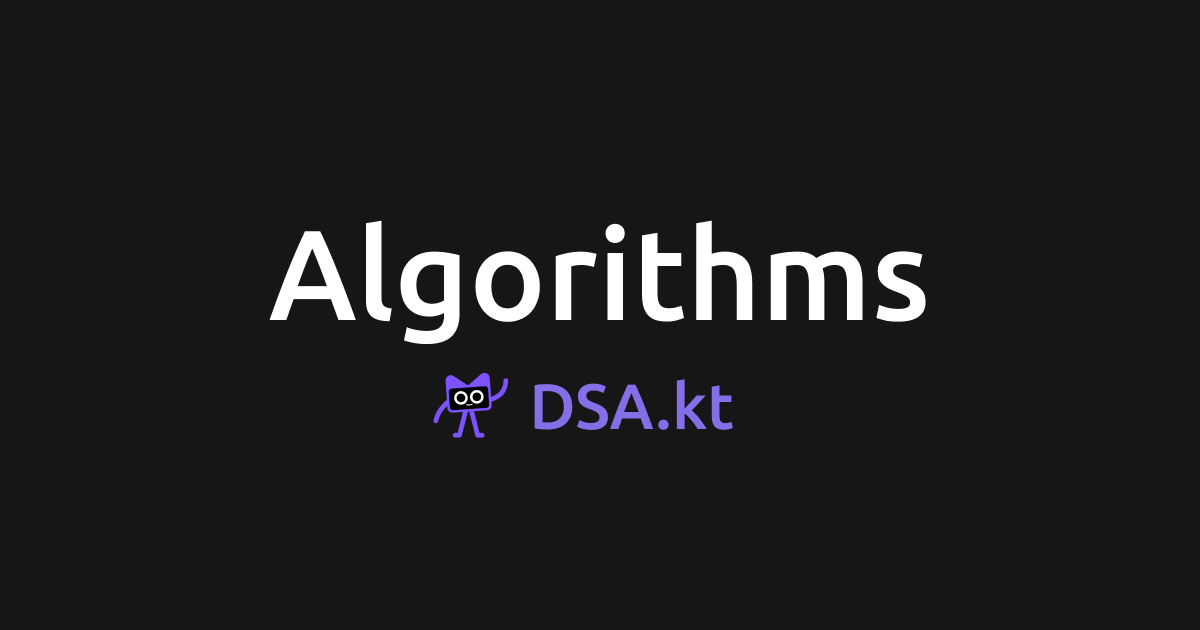What are Algorithms?

According to Wikipedia,
In mathematics and computer science, an algorithm is a finite sequence of mathematically rigorous
instructions, typically used to solve a class of specific problems or to perform a computation.
In Simple words,
An algorithm is a set of well-defined steps to solve a particular problem or perform a specific
task.
In other words,
It’s the step-by-step procedure to solve a problem.
But a good algorithm is more than just a set of steps. It’s about efficiency, correctness, and
elegance. It’s about finding the best way to solve a problem, not just any way.
An algorithm is a step-by-step procedure or a set of instructions designed to perform a specific
task or solve a particular problem. Algorithms are the foundation of computer science and are used
in everything from simple calculations to complex machine learning models.
In real-world scenarios,
You can think of an algorithm as the process you follow to make a cup of tea. You have a set of
instructions (e.g., boil water, add tea leaves, pour milk) that, when followed correctly, produce
the desired outcome (a cup of tea). Similarly, algorithms provide a systematic way to solve problems
and achieve specific goals in computing.

Caption: Tea Making
Whether it’s brewing the perfect cup of tea or designing a complex machine learning model, the
effectiveness of an algorithm depends on its ability to achieve the desired outcome efficiently and
elegantly.
In essence, an algorithm takes an input, processes it in a defined manner, and produces an output.
The efficiency and correctness of algorithms are critical for building high-performance and reliable
applications.
Why Do We Need Algorithms?
If there’s one thing that’s constant in programming, it’s the need to solve problems efficiently.
There will always be tasks that require processing data, making decisions, or optimizing resources.
Algorithms provide a structured approach to problem-solving, offering several benefits:
- Problem-Solving:
Algorithms are essential for solving computational problems, from sorting a list of numbers to
finding the shortest path in a network. - Efficiency:
A well-designed algorithm ensures tasks are completed with minimal time and resource usage, which
is critical for scaling applications. - Optimization:
Algorithms optimize processes by finding the best solution among many possibilities, whether it’s
minimizing cost or maximizing performance. - Automation:
Algorithms enable automation by defining a clear sequence of operations, eliminating the need for
manual intervention. - Reusability:
Once developed, algorithms can be reused across different applications, saving time and effort in
future projects. - Scalability:
Algorithms help applications scale by efficiently handling increasing amounts of data or
requests. - Consistency:
Algorithms provide a consistent approach to solving problems, reducing errors and ensuring
reliability. - Innovation:
Algorithms drive innovation by enabling the development of new technologies and solutions to
complex problems. - Competitive Advantage:
Efficient algorithms can give businesses a competitive edge by improving performance and reducing
costs. - Learning:
Understanding algorithms is essential for learning computer science concepts and improving
problem-solving skills.
Algorithms are the building blocks of software development, enabling developers to create efficient
and reliable solutions to a wide range of problems. Now, let’s explore how Kotlin makes implementing these algorithms both simpler and more efficient.
Algorithms in Kotlin
Kotlin provides a concise and expressive syntax for implementing algorithms. Its modern features,
such as extension functions, immutable collections, and null safety, make writing
algorithms easier and less error-prone. Additionally, Kotlin is interoperable with Java, allowing
developers to leverage Java libraries and tools for algorithm development.
Key Features of Kotlin for Algorithms
Extension Functions:
Kotlin allows you to add custom functionality to existing classes, making algorithms more readable
and reusable.Lambda Expressions:
Higher-order functions and lambda expressions simplify the implementation of functional
programming techniques in algorithms.Null Safety:
Kotlin’s null safety features reduce the risk ofNullPointerException, a common issue when
working with data in algorithms. This ensures more robust and predictable code.Immutable Collections:
Kotlin encourages the use of immutable collections (listOf,setOf,mapOf), which help
prevent accidental modifications to data during algorithm execution, ensuring safer and more
predictable behavior.Concise Syntax:
Kotlin reduces boilerplate code, allowing algorithms to be written with greater clarity and less
overhead.Interoperability with Java:
Kotlin seamlessly integrates with Java libraries, enabling developers to use well-established
libraries like Apache Commons, Guava, or JGraphT for advanced algorithms, while still benefiting
from Kotlin’s modern syntax.
Kotlin’s features make it an excellent choice for both learning and implementing algorithms. Its
combination of simplicity, safety, and flexibility empowers developers to write clean and efficient
solutions to a wide range of computational problems.
Categories of Algorithms
Algorithms can be broadly classified based on their design paradigm or the type of problem they
solve. Understanding these categories helps in selecting the right approach for specific
computational tasks. Algorithms can be categorized based on their approach or the type of problem they address. Below are some key categories and their typical applications.
1. Sorting Algorithms
Sorting algorithms are used to arrange elements in a particular order (e.g., ascending or
descending). They form the foundation of many other algorithms and data-processing tasks. Examples
include:
- Bubble Sort
- Merge Sort
- Quick Sort
- Insertion Sort
2. Searching Algorithms
Searching algorithms are designed to find an element or determine if it exists in a dataset. Common
examples include:
- Linear Search
- Binary Search
3. Divide and Conquer
This paradigm breaks a problem into smaller subproblems, solves them independently, and combines the
results. It’s used in algorithms like:
- Merge Sort
- Quick Sort
- Binary Search
4. Dynamic Programming
Dynamic programming solves problems by breaking them into overlapping subproblems, storing results
to avoid redundant computations. Examples include:
- Fibonacci Sequence
- Knapsack Problem
- Longest Common Subsequence (LCS)
5. Greedy Algorithms
Greedy algorithms make the locally optimal choice at each step with the hope of finding a global
optimum. Examples include:
- Dijkstra’s Algorithm (shortest path)
- Prim’s Algorithm (minimum spanning tree)
6. Backtracking
Backtracking explores all possibilities for solving a problem by building a solution incrementally
and abandoning paths that lead to dead ends. Examples include:
- N-Queens Problem
- Sudoku Solver
- Knapsack Problem (brute force)
7. Brute Force Algorithms
These algorithms solve problems by trying all possible solutions. They are simple but often
inefficient for large inputs. Examples include:
- Password Cracking
- Generating Permutations
8. Graph Algorithms
Graph algorithms deal with problems related to graph structures, such as finding paths,
connectivity, and spanning trees. Examples include:
- Breadth-First Search (BFS)
- Depth-First Search (DFS)
- Kruskal’s Algorithm (minimum spanning tree)
- Bellman-Ford Algorithm
9. Mathematical Algorithms
Mathematical algorithms are used for computations like prime factorization, GCD, and matrix
operations. Examples include:
- Euclidean Algorithm (GCD)
- Sieve of Eratosthenes (prime numbers)
- Matrix Multiplication
10. Recursive Algorithms
Recursive algorithms solve problems by calling themselves with smaller inputs. They’re often
combined with divide-and-conquer or dynamic programming. Examples include:
- Factorial Calculation
- Tower of Hanoi
- Fibonacci Sequence
11. Optimization Algorithms
Optimization algorithms aim to find the best solution from a set of possible solutions. Examples
include:
- Linear Programming
- Simulated Annealing
- Genetic Algorithms
12. String Algorithms
String algorithms handle problems related to string processing and manipulation. Examples include:
- KMP Algorithm (string matching)
- Rabin-Karp Algorithm
- Suffix Array Construction
13. Machine Learning Algorithms
Although not traditional, machine learning algorithms are crucial in modern computing for tasks like
classification and clustering. Examples include:
- Gradient Descent
- K-Means Clustering
- Support Vector Machines (SVM)
Each of these categories serves a unique purpose and has its strengths and weaknesses. Understanding
when and how to use them is key to solving problems efficiently.
Choosing the Right Algorithm
When selecting an algorithm, consider the following:
Problem Type:
Match the algorithm to the problem (e.g., use a sorting algorithm for ordering data).Efficiency Requirements:
Choose an algorithm that balances time complexity and space complexity based on your
application’s needs.Input Size:
Algorithms like Quick Sort are efficient for large datasets, while simpler algorithms like Bubble
Sort are better for small datasets.Ease of Implementation:
Kotlin’s built-in functions often provide efficient solutions for common algorithmic problems.Scalability:
Consider how the algorithm performs as the input size grows. Some algorithms scale better than
others.Optimization:
Look for ways to optimize the algorithm based on the problem constraints and input
characteristics.Trade-offs:
Understand the trade-offs between different algorithms in terms of time, space, and complexity.
Conclusion
Algorithms are the core of problem-solving in programming. With Kotlin’s concise syntax, powerful
standard library, and modern features, implementing algorithms becomes simpler and more efficient.
Whether you’re sorting a list, navigating a graph, or optimizing a solution, understanding and
applying algorithms is key to becoming a proficient Kotlin developer.
By mastering different algorithm categories and choosing the right approach for each problem, you can build robust, scalable, and efficient applications. Algorithms are the tools that empower developers to solve complex problems, automate tasks, and innovate in the world of software development.